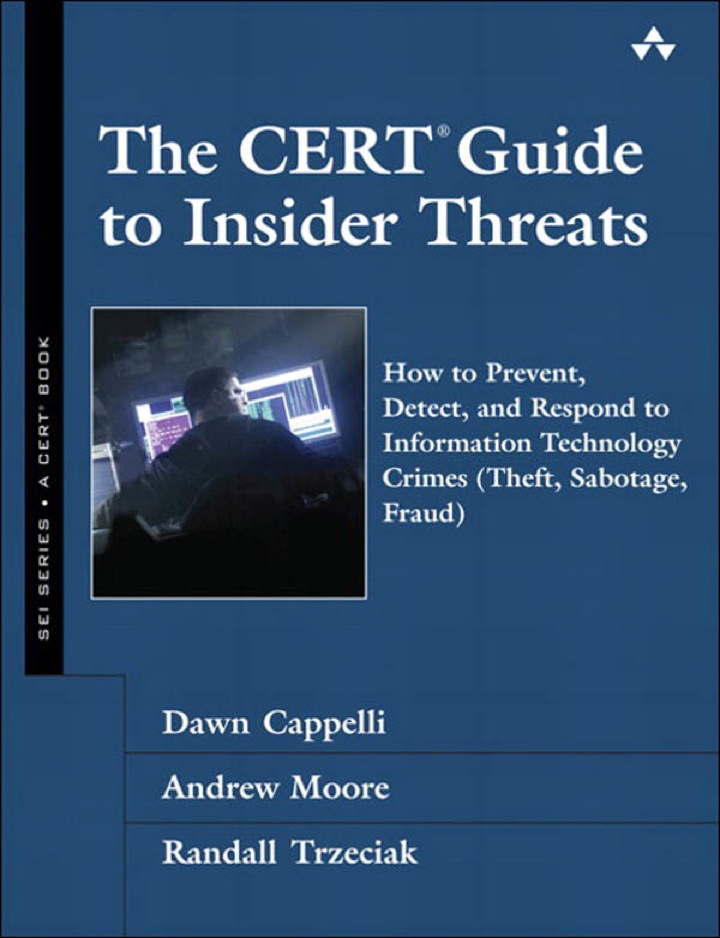
The CERT Guide to Insider Threats: How to Prevent, Detect, and Respond to Information Technology Crimes (Theft, Sabotage, Fraud), 1st edition
PUBLISHER: PEARSON
eBook edition. 1 Year Subscription. Dành cho Cá nhân | Trường ĐH, Nhóm, Thư Viện: Gọi 0915920514 để báo giá Pearson, Vital Source eBook hoặc mua Sách In
Kể từ năm 2001, Trung tâm Đe dọa Nội bộ CERT® tại Viện Kỹ thuật Phần mềm (SEI) của Đại học Carnegie Mellon đã thu thập và phân tích thông tin về hơn 700 tội phạm mạng nội bộ, từ gián điệp an ninh quốc gia đến đánh cắp bí mật thương mại. Hướng dẫn của CERT® về các mối đe dọa nội bộ mô tả những phát hiện của CERT bằng thuật ngữ thực tế, đưa ra hướng dẫn và biện pháp đối phó cụ thể mà các giám đốc điều hành, nhà quản lý, nhân viên an ninh và nhân viên vận hành trong bất kỳ tổ chức tư nhân, chính phủ hoặc quân đội nào có thể áp dụng ngay lập tức.Các tác giả giải quyết một cách có hệ thống các cuộc tấn công của tất cả các loại nội bộ độc hại, bao gồm nhân viên hiện tại và trước đây, nhà thầu, đối tác kinh doanh, người đăng việc và thậm chí cả nhà cung cấp điện toán đám mây. Chúng bao gồm tất cả các loại tội phạm mạng nội bộ chính: phá hoại CNTT, trộm cắp tài sản trí tuệ và lừa đảo. Đối với mỗi người, họ trình bày hồ sơ tội phạm mô tả cách tội phạm có xu hướng phát triển theo thời gian, cũng như động cơ, phương pháp tấn công, các vấn đề về tổ chức và các cảnh báo báo trước có thể giúp tổ chức ngăn chặn vụ việc hoặc phát hiện nó sớm hơn. Ngoài việc xác định các mô hình hành vi đáng ngờ quan trọng, các tác giả còn trình bày các biện pháp phòng thủ cụ thể để bảo vệ cả hệ thống và dữ liệu.
- Preface xviiAcknowledgments xxxi
- Chapter 1: Overview 1True Stories of Insider Attacks 3The Expanding Complexity of Insider Threats 6Breakdown of Cases in the Insider Threat Database 7CERT’s MERIT Models of Insider Threats 9Overview of the CERT Insider Threat Center 13Timeline of the CERT Program’s Insider Threat Work. 16Caveats about Our Work 20Summary 20
- Chapter 2: Insider IT Sabotage 23General Patterns in Insider IT Sabotage Crimes 28Mitigation Strategies 46Summary 59
- Chapter 3: Insider Theft of Intellectual Property 61Impacts 66General Patterns in Insider Theft of Intellectual Property Crimes 68The Entitled Independent 69The Ambitious Leader 78Theft of IP inside the United States Involving Foreign Governments or Organizations 83Mitigation Strategies for All Theft of Intellectual Property Cases 88Mitigation Strategies: Final Thoughts 97Summary 98
- Chapter 4: Insider Fraud 101General Patterns in Insider Fraud Crimes 106Insider Fraud Involving Organized Crime 115Organizational Issues of Concern and Potential Countermeasures 120Mitigation Strategies: Final Thoughts 126Summary 127
- Chapter 5: Insider Threat Issues in the Software Development Life Cycle 129Requirements and System Design Oversights 131System Implementation, Deployment, and Maintenance Issues 136Programming Techniques Used As an Insider Attack Tool 139Mitigation Strategies 142Summary 143
- Chapter 6: Best Practices for the Prevention and Detection of Insider Threats 145Summary of Practices 146Practice 1: Consider Threats from Insiders and Business Partners in Enterprise-Wide Risk Assessments 151Practice 2: Clearly Document and Consistently Enforce Policies and Controls 155Practice 3: Institute Periodic Security Awareness Training for All Employees 159Practice 4: Monitor and Respond to Suspicious or Disruptive Behavior, Beginning with the Hiring Process 164Practice 5: Anticipate and Manage Negative Workplace Issues 168Practice 6: Track and Secure the Physical Environment 171Practice 7: Implement Strict Password- and Account-Management Policies and Practices 174Practice 8: Enforce Separation of Duties and Least Privilege 178Practice 9: Consider Insider Threats in the Software Development Life Cycle 182Practice 10: Use Extra Caution with System Administrators and Technical or Privileged Users 187Practice 11: Implement System Change Controls 191Practice 12: Log, Monitor, and Audit Employee Online Actions 195Practice 13: Use Layered Defense against Remote Attacks 200Practice 14: Deactivate Computer Access Following Termination 203Practice 15: Implement Secure Backup and Recovery Processes 207Practice 16: Develop an Insider Incident Response Plan 211Summary 213References/Sources of Best Practices 214
- Chapter 7: Technical Insider Threat Controls 215Infrastructure of the Lab 217Demonstrational Videos 218High-Priority Mitigation Strategies 219Control 1: Use of Snort to Detect Exfiltration of Credentials Using IRC 220Control 2: Use of SiLK to Detect Exfiltration of Data Using VPN 221Control 3: Use of a SIEM Signature to Detect Potential Precursors to Insider IT Sabotage 223Control 4: Use of Centralized Logging to Detect Data Exfiltration during an Insider’s Last Days of Employment 231Insider Threat Exercises 239Summary 239
- Chapter 8: Case Examples 241Sabotage Cases 241Sabotage/Fraud Cases 256Theft of IP Cases 258Fraud Cases 262Miscellaneous Cases 269Summary 273
- Chapter 9: Conclusion and Miscellaneous Issues 275Insider Threat from Trusted Business Partners 275Malicious Insiders with Ties to the Internet Underground 286Final Summary 293Appendix A: Insider Threat Center Products and Services 299Appendix B: Deeper Dive into the Data 307Appendix C: CyberSecurity Watch Survey 319Appendix D: Insider Threat Database Structure 325Appendix E: Insider Threat Training Simulation: MERITInterActive333Appendix F: System Dynamics Background 345Glossary of Terms 351References 359About the Authors 365Index 369















